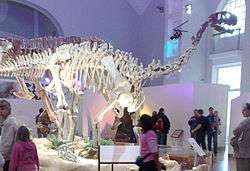Shunosaurus
| Shunosaurus Temporal range: Middle Jurassic, 170 Ma | |
|---|---|
 | |
| Mount in Helsinki | |
| Scientific classification | |
| Kingdom: | Animalia |
| Phylum: | Chordata |
| Class: | Reptilia |
| Clade: | Dinosauria |
| Order: | Saurischia |
| Suborder: | †Sauropodomorpha |
| Clade: | †Eusauropoda |
| Genus: | †Shunosaurus Dong et al., 1983 |
| Species: | †S. lii |
| Binomial name | |
| Shunosaurus lii Dong et al., 1983 | |
Shunosaurus, meaning "Shu Lizard", is a genus of sauropod dinosaur from Middle Jurassic (Bathonian–Callovian) beds in Sichuan Province in China, 170 million years ago. The name derives from "Shu", an ancient name for the Sichuan province.
Discovery and species
The first fossil of Shunosaurus was discovered in 1977 by a group of students, practising paleontological excavation at a road bank. The type species, Shunosaurus lii, was described and named by Dong Zhiming, Zhou Shiwu and Zhang Yihong in 1983. The generic name derives from "Shu", an ancient name for Sichuan. The specific name honours hydrologist Li Bing, the governor of Sichuan in the third century BC.[1]
The holotype, IVPP V.9065, was collected from the Lower Xiashaximiao Formation near Dashanpu, Zigong. It consists of a partial skeleton. Later about twenty more major specimens were discovered, including several complete or near-complete skeletons, skulls and juveniles, making Shunosaurus one of the best anatomically known sauropods, with 94% of all skeletal elements identified. Shunosaurus skeletons are on display at the Zigong Dinosaur Museum in Zigong, Sichuan Province, and the Beijing Museum of Natural History.
A second species, S. ziliujingensis, a name mentioned in the Zigong museum guide to indicate a smaller and older form, has never been formally described, and thus remains a nomen nudum.
Description

Shunosaurus was first estimated to be 11 metres (36 ft) long; later and more complete finds indicated a somewhat smaller size. In 2010 Gregory S. Paul estimated the length at 9.5 metres (31 ft), the weight at 3 metric tons (3.3 short tons).[2] Shunosaurus was very short-necked for a sauropod, being only "surpassed" in this respect by Brachytrachelopan.[3] The skulls found are mostly compressed or disarticulated and the interpretation of the head form has varied from broad, short and deep[4] to extremely narrow and pointed.[5] The upper and lower jaws were strongly curved upwards, allowing them to function as a pair of garden shears. The teeth were fairly robust but elongated with a crown length of up to 8 centimetres (3.1 in). They show a unique combination of a cylindrical body ending in a spatulate tip. In 1989 it was disclosed that the tail ended in a club,[6] equipped on its top with two successive spikes formed by 5 centimetres (2.0 in)-long cone-shaped osteoderms probably used to fend off enemies.
Classification

Shunosaurus was originally classified as a member of the Cetiosaurinae; in 1992 Dong assigned it to Shunosaurinae within the Cetiosauridae.[7]
Cladistic analyses have rendered conflicting results. In 1995 Paul Upchurch published a study in which Shunosaurus belonged to the Euhelopodidae together with other Jurassic Chinese sauropods.[8] However, an analysis by Jeffrey Wilson in 2002 indicated it had a very basal position within the Eusauropoda.[9] Shunosaurus is perhaps related to Rhoetosaurus from Queensland in Australia.
The cladogram below shows a possible phylogenetic position:[10]
| Sauropoda |
| |||||||||||||||||||||||||||||||||||||||||||||||||||||||||||||||
| |
Paleobiology

Its neck length indicates that Shunosaurus was a low browser. The form of its jaws is well-adapted to processing large amounts of coarse plant material.[11]
Shunosaurus accounts for 90% of the fossils found in the Dashanpu fauna, showing it was a dominant member of its habitat. It shared the local Middle Jurassic landscape with other sauropods, Datousaurus, Omeisaurus and Protognathosaurus, the possible ornithopod Xiaosaurus, and the early stegosaur Huayangosaurus, as well as the carnivorous theropod Gasosaurus.
References
- ↑ Dong, Z., Zhou, S. & Zhang, Y. 1983. [Dinosaurs from the Jurassic of Sichuan]. Palaeontologica Sinica, New Series C 162(23): 1-136
- ↑ Paul, G.S., 2010, The Princeton Field Guide to Dinosaurs, Princeton University Press p. 173
- ↑ Paul, G.S., 2010, The Princeton Field Guide to Dinosaurs, Princeton University Press p. 175
- ↑ Paul, G.S., 2010, The Princeton Field Guide to Dinosaurs, Princeton University Press p. 174
- ↑ Zheng , Zhong (1996). Cranial Anatomy of Shunosaurus and Camarasaurus (Dinosauria: Sauropoda) and the phylogeny of the Sauropoda. Dissertation Texas Tech University. pp. 208
- ↑ Dong Z., Peng G., Huang D. 1989. [The discovery of the bony tail club of sauropods]. Vertebrata Palasiatica 27: 219–224
- ↑ Dong Zhiming (1992). Dinosaurian Faunas of China. China Ocean Press, Beijing. ISBN 3-540-52084-8.
- ↑ P. Upchurch. 1995. "The evolutionary history of sauropod dinosaurs". Philosophical Transactions of the Royal Society of London B 349: 365-390
- ↑ J. A. Wilson. 2002. "Sauropod dinosaur phylogeny: critique and cladistic analysis". Zoological Journal of the Linnean Society 136: 217-276
- ↑ J.A. Wilson, 2002, "Sauropod dinosaur phylogeny: critique and cladistic analysis", Zoological Journal of the Linnean Society 136: 217-276
- ↑ Chatterjee, S. & Zheng, Z. 2002. "Cranial anatomy of Shunosaurus, a basal sauropod dinosaur from the Middle Jurassic of China". Zoological Journal of the Linnean Society 136(1): 145–169
- Dong Zhiming (1988). Dinosaurs from China. China Ocean Press, Beijing & British Museum (Natural History). ISBN 0-565-01073-5.
| Wikimedia Commons has media related to Shunosaurus. |